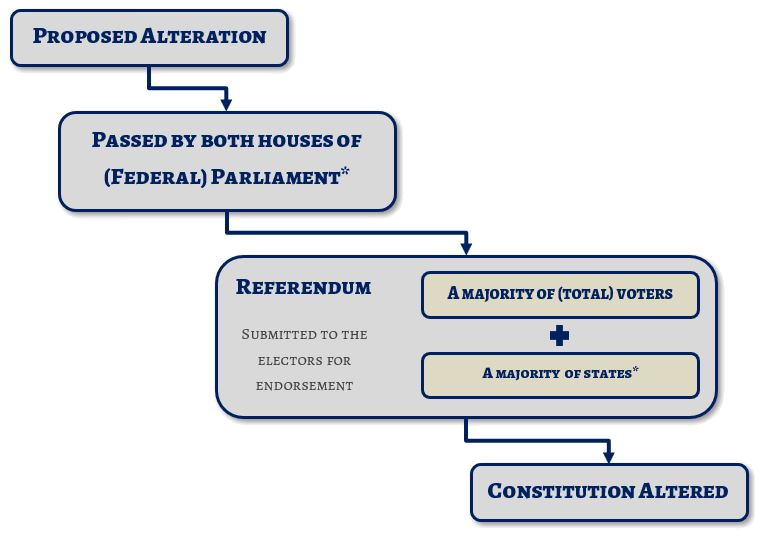Altering the Constitution
The Australian Constitution was never intended to be a static document – from its initial inception it was designed so that it could be adapted and changed to reflect changing social circumstances. The Constitution provides a mechanism by which it can be altered, called a referendum. The precise requirements by which the Constitution can be amended are set out in Section 128 of the Constitution, which is set out below:
For an accessible overview of how referendums work, have a look at this Expert Explainer:
Constitutional Provision for Altering the Constitution
|
|
Section 128: Mode of altering the Constitution |
|
Understanding s128
The wording of s128 is cumbersome and unwieldy - these terms all mean something to lawyers, but can appear daunting to the public. The basic idea is that (generally):
To alter the Constitution, that proposal must achieve a double majority, that is:
This process was designed to ensure that any change to the Constitution could achieve a broad political and social legitimacy by ensuring that a sufficiently broad and deep constituency of Australians support that change.
This process can be visualised in the following way:
- Both Houses of the Commonwealth Parliament must pass a proposed law containing the suggested amendment of the Constitution.
- That proposal must then be put to the electorate.
To alter the Constitution, that proposal must achieve a double majority, that is:
- a majority of electors must vote in favour of the change; and
- a majority vote in a majority of States (that is, in four out of the six States) must vote in favour of the change
This process was designed to ensure that any change to the Constitution could achieve a broad political and social legitimacy by ensuring that a sufficiently broad and deep constituency of Australians support that change.
This process can be visualised in the following way:

* NOTE: The process described above is the normal course by which constitutional change is affected. There are variations in certain circumstances
The Case Study below The Constitution as a Pub helps us understand the role of referendum in maintaining the Constitution (click on the + to expand):
|
|
Case Study: The Constitution as a Pub
We can get an idea of the role of referendum and constitutional change by think of the Constitution a bit like an old Pub building. Next door to UniSA is an pub. There has been a pub on that site since 1838. Originally named The Royal Oak, it was once at the heart of Adelaide’s West End. In the last 175 years it has gone through several incarnations, many updates and refurbishments, yet survives as one of the city’s oldest continual licensed venues. It that time, it was never enough simply to preserve the building as it was, to keep it the same. Sure, it could be quaint and nostalgic to have a colonial experience (for some), and you could still get a beer. But expectations and community standards have moved on in the last two centuries; we have got used to cutting edge technology like electric lights, indoor toilets, cold beer maybe even a glass of wine. We expect everyone to be welcome in the building (not just men of a certain race). Air conditioning is nice in summer. This Pub is vibrant precisely because it has not only been preserved, it has been maintained and renovated. You put the electricity in. You knock down a few walls. Glass in the windows. We enhance the building to better reflect technology and society. Now, 175 years later, that building is still a pub, it is still performing fundamentally the same function – but it is doing so in a way appropriate and adapted to the needs of our modern society. We can think of our Constitution in the same way. One hundred years later it is still doing its basic job – but society and its expectations have moved on. Some renovations we can do through shifts in conventions and practices. Sometimes the courts can revisit interpretations – maybe that lets some more light in. But sometimes we need to knock down a wall – affect serious reform – and that takes a referendum. There is nothing untoward about this – it is precisely what we need to do to ensure the Constitution remains vibrant and vital into the next century Further Resources
|

